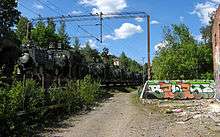Military railways

The military use of railways derives from their ability to move troops or materiel rapidly and, less usually, on their use as a platform for military systems, like armoured trains, in their own right. Railways have been employed for military purposes since the Crimean War in the 1850s, although improvements in other forms of transport have rendered railways less important to the military since the end of World War II and the Cold War, although they are still employed for the transport of armoured vehicles to and from exercises or the mass transport of vehicles to a theatre of operations. Due to the expense and time required to build specifically military railway networks, military use of railways is usually based on a pre-existing civilian railway network rather than a military-owned one. However, specialized military types of rolling stock have frequently been used. Military railway are usually built and operated by railway troops.
Military railways
- British military narrow gauge railways
- Melbourne Military Railway
- Bicester Military Railway
- Fort Eustis Military Railroad
Military use of railways in history



Crimean War
One of the first uses of military railways was to establish a reliable supply to British Army troops besieging the city of Sevastopol from Balaklava during the severe winter of 1855 in the Crimean War. The Grand Crimean Central Railway was just 7 miles (11 km) long, and was purpose built.
American Civil War
United States Military Railroad known as the City Point Railroad, which extended to Petersburg during the Siege of Petersburg during the American Civil War in 1864 -1865.
Paraguayan War
In 1867 during the Paraguayan War some ironclad vessels of the Brazilian navy became trapped on the River Paraguay between the enemy Paraguayan forts of Curupaty and Humaitá. To keep them supplied with fuel, ammunition and provisions the Brazilian ministry of marine ordered an emergency military railway to be built through the almost impenetrable coastal region of the Chaco. The sleepers of this line almost floated over the boggy ground. This supply line was known as the Affonso Celso, and sustained the ironclads in their precarious position for six months, until they were able to dash past the Fortress of Humaitá in an incident known as the Passage of Humaitá.
Russian use in Asia
Trans-Siberian Main Railway (Транссибирская железнодорожная магистраль - Транссиб), before 1917 was named The Great Siberian Way (Великий Сибирский Путь). First construction begun on 19 May (31 May) 1891.
Mahdist War
In 1896-98 during the Mahdist War, Kitchener extended the Egyptian railways into the Sudan.
World War I
Narrow gauge military railways serviced the Western Front, see Trench railways, Decauville (French), Feldbahn and Heeresfeldbahn (German and Austrian) and War Department Light Railways (British).
World War II
Japan built several railways for military purposes, notably the Burma-Siam Railway, known as the Death Railway because of the number of Allied prisoners-of-war and Asian labourers who died constructing it.
The existing Northeast Indian Railways were expanded by the Americans to supply China via the Ledo Road.
See also
- Central Asian Military railway
- Feldbahn
- Heeresfeldbahn - German and Austrian military railways
- Light railway
- Longmoor Military Railway - built by the Royal Engineers in order to train on railway operations on it. It closed in 1969.
- War Department Light Railways
- Railway troops
External links
- "They're Highballing Now." Popular Science, February 1945, pp. 77–83, article on the landing of 1000s of rolling stock across D-Day beaches During World War II and rebuilding of French railways.
Sources and references
- Vecamer, Arvo L., Deutsche Reichsbahn: The German State Railway in WWII,
- Connor, W.D., Maj., Military Railways, Professional Papers No.32, Corps of Engineers US Army, Revised edition 1917, Government Printing Office, Washington DC, 1917.